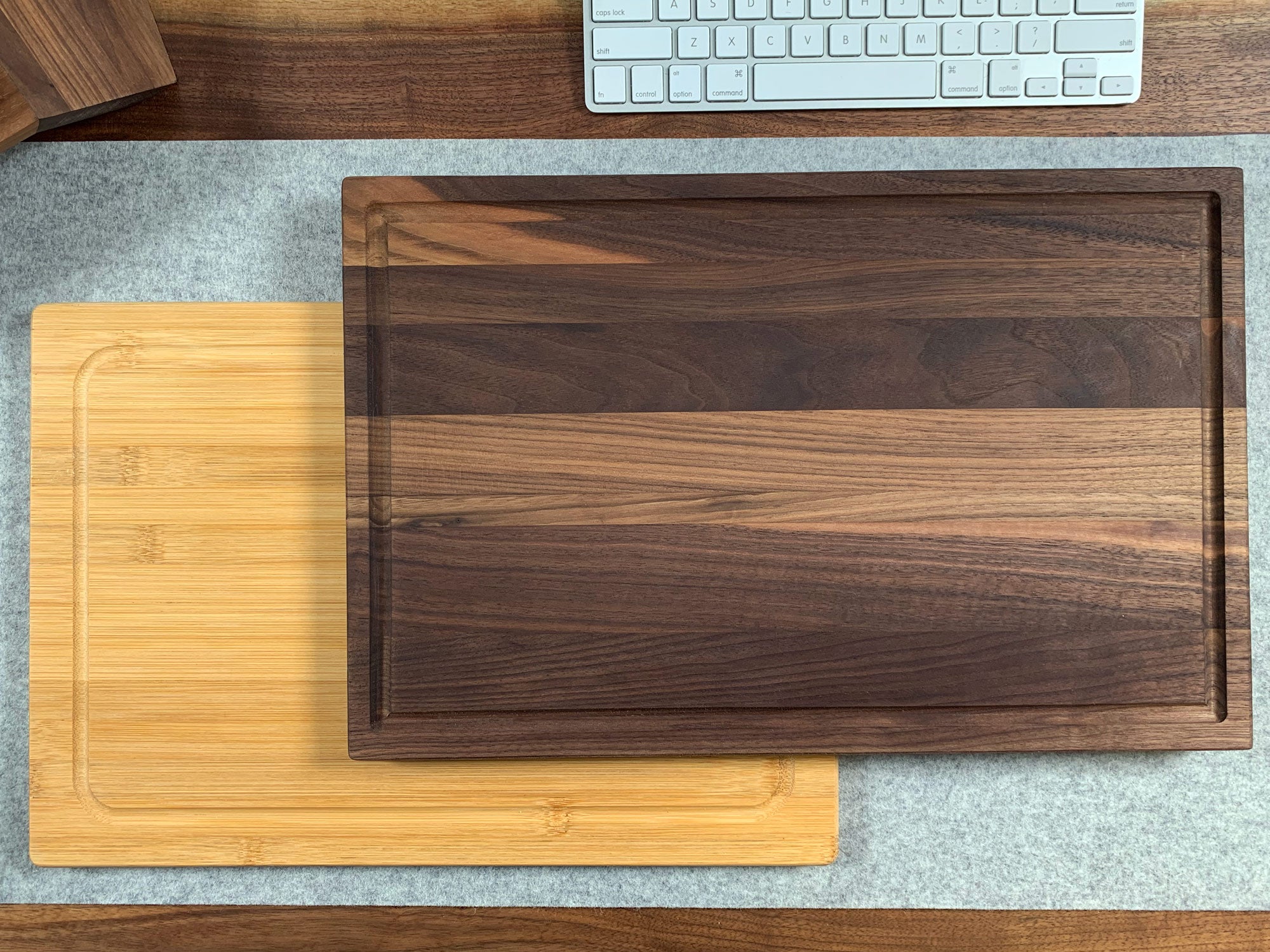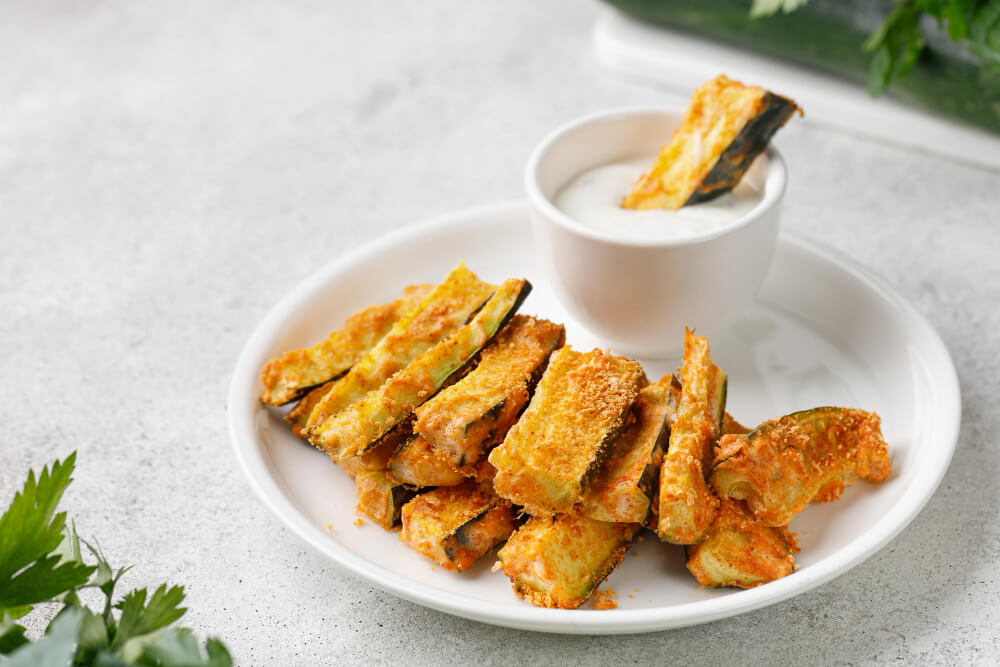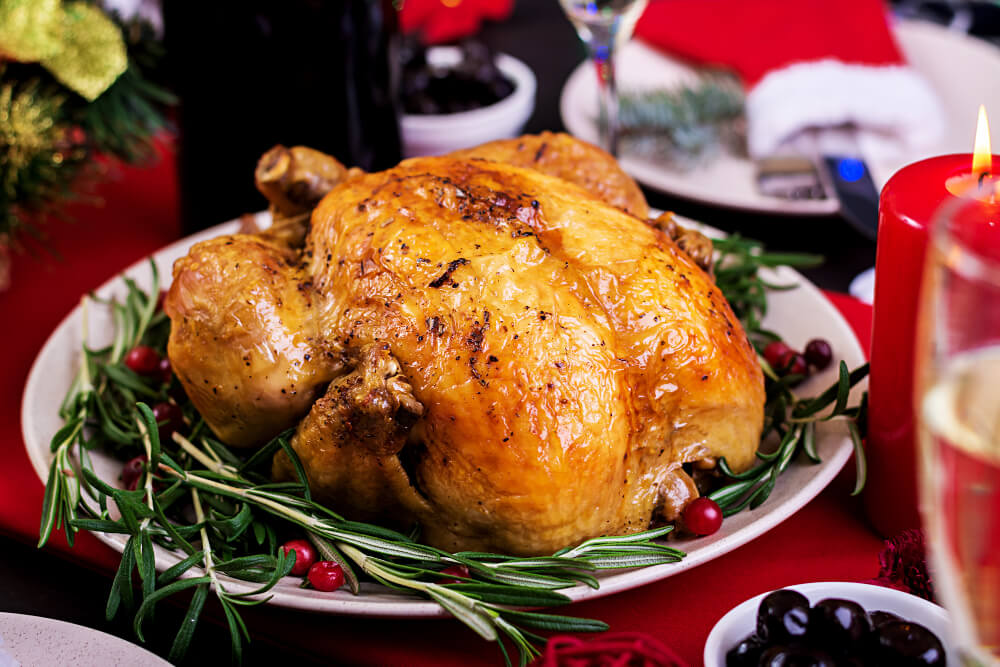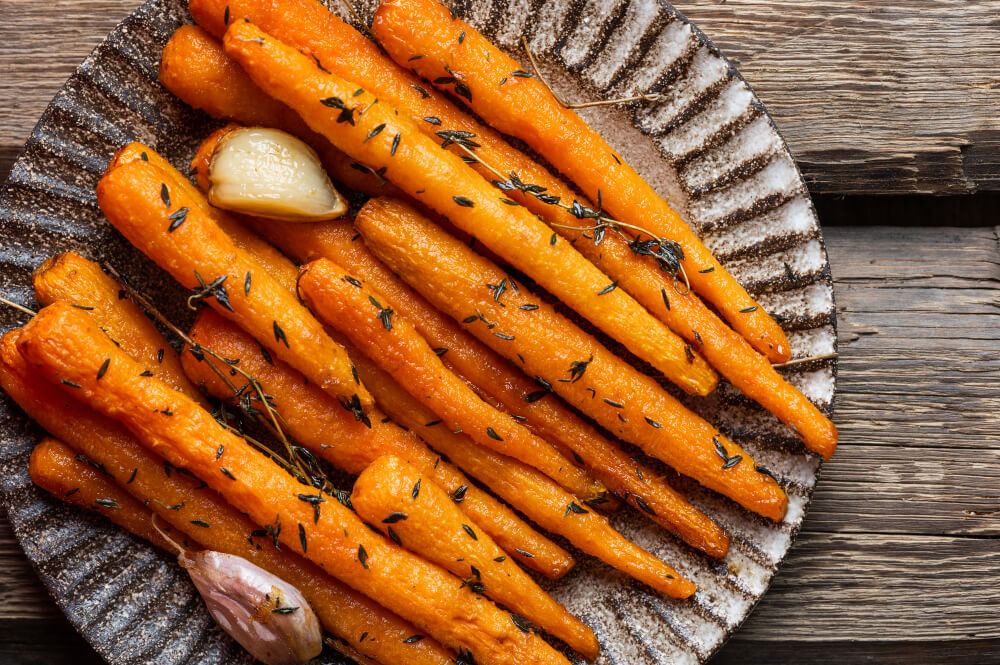
The main difference between wood and bamboo cutting boards is porosity, toxicity, and hardness. Bamboo grains are non-porous, highly durable, and full of silica; hence very tough on knives and will dull the blade. In addition, bamboo is considered a grass; it can splinter easily and harbor bacteria.
Various cutting board options are available, including wood, plastic, and glass. While glass may be suitable for glassware, we highly recommend a high-quality hardwood option such as Walnut or Maple for your cutting board needs.
Key factors to consider when choosing a cutting board
The type of wood used on a cutting board can significantly impact its performance and longevity.
Different types of wood have different properties, such as hardness, porosity, grain, and toxicity, that can affect the lifespan of the board, food safety, and how you use the board. Choosing the right cutting board that fits your needs and preferences is vital. It is essential to consider these factors when searching for the perfect cutting board.
1. Wood Hardness
When selecting a wood cutting board, it's essential to consider its hardness. Hardness is measured by the Janka test, which calculates the pounds of force needed to push a steel ball halfway into a piece of wood. A lower Janka rating indicates a softer wood, while a higher rating denotes a harder wood.
Too soft wood can easily scratch and damage, while too hardwood can dull knives' edges over time. For that reason, we recommended choosing wood species with a Janka Hardness rating between 900-1500 for cutting boards. Examples of wood species that fall in this range include:
Janka Hardness Rating for Hard-Wood
| Wood Type | Hardness in lbf |
| Strand Bamboo | 4600 |
| Acacia | 2000 |
| Hard Maple | 1450 |
| Bamboo | 1410 |
| Walnut | 1010 |
| Cherry | 995 |
A rule of thumb is to choose moderately hard and dense hardwoods.
Avoid cutting boards made from softwood; they easily crack and warp, quickly lose their shape, and are easily damaged by knives. Look at this article, where de dive deep into the type of wood used in a cutting board.
2. Wood Grain Porosity
Hardwood trees have pores or vessels that transport sap. You can spot these pores throughout the tree. In contrast, softwoods use tracheids to transport the sap.
It helps to understand how the different pores affect a cutting board. By doing so, you'll be able to pick a board that soaks up less moisture.
- Ring porous – refers to woods with large pores, e.g., oak, & ash. see the image above.
- Semi-ring porous.
- Diffuse porous.
- Non-porous - closed grain
Large pores are the same as having deep scratches and cuts on the surface of your board. These large pores trap bacteria and moisture. Some hardwoods with large pores include ash, red oak, hickory, and elm.
In contrast, hardwood with smaller pores or closed grain makes the best cutting boards.
When referring to the size of the pores, they are differentiated using the terms 'open-grained' and 'close-grained', defined from a tree's grain orientation. The arrangement, size, and distribution of pores differentiate between fine-grain and coarse-grain. Wood grain determines how smooth or coarse a piece of wood will be.
Wood grain or grain orientation refers to the pattern created by the arrangement of wood cell fibers. It describes the appearance, texture, and alignment of wood fibers.

Red Oak Open Pores
Open grain describes woods with visible pores –you can notice the pores with your naked eye.
In contrast, 'closed grain' or "fine-grained" refers to woods with small vessels and tiny pores, only visible with a special microscope. Maple and sycamore fall in this category. Mahogany and Walnut are medium-grained.
A wood board could have a tremendous grain amount, depending on how the woodworker has cut it. The technique used to cut the board determines how the board dries up and even how it absorbs a finishing coat.
A golden-standard practice is to go with closed-grain boards. They not only have smaller pores, but also they have a smooth finish. Unlike open-grain have large pores that act as passages for liquids and bits of food. Ultimately, these large pores trap bacteria, mold, and stains. We can compare the large pores to having deep scratches or cuts on the face of the board.
Woods that absorb liquids warp and deform with time. That's because as the wood absorbs and releases moisture, it influences millions of micro-movements, stressing the wood's shape. That said, boards made from ash, oak, hickory, and elm aren't the best wood cutting boards because they have large pores.
3 Toxicity - Are All boards Safe
Wood toxicity can manifest as irritation, sensitivity, or food poisoning. Some woods are food safe – others are toxic.
You can't go wrong with boards made from trees well-known to produce edible fruits & nuts. Good examples here include Walnut, maple, and cherry.
Exotic woods are not recommended for kitchen use. Most exotic woods may contain toxins that may contaminate your food. Rosewood is one example of hardwood that has toxic characteristics. Boards built from Rosewood can leach oils into your foods. Some people are allergic to these oils.
Also, choose boards made using non-toxic components. Always verify that elements like glue, conditioners, and finishes used to seal the board are all non-toxic.
Our handcrafted wood cutting boards have been glued using TiteBond 3 Food-grade glue, which is waterproof, food-safe, and solvent free.
Also we season our boards with Food-Grade mineral oil and natural beeswax.
With that said, let's look at how bamboo compares with various hardwood species.
Bamboo Cutting Boards Pros and Cons
A common question is whether bamboo cutting boards are as good as wooden ones. Of course, they are not as good as wood ones, but it largely depends on personal preferences and needs.
Some people may prefer bamboo for a few reasons, and the most obvious one is its cost. Bamboo cutting boards are often significantly cheaper than wooden ones.
Another reason is maintenance; bamboo cutting boards do not require as much care and can be more forgiving if accidentally thrown in the dishwasher.
On the other hand, wooden cutting boards are considered a higher-end product requiring a bit more attention. It's not difficult, but it's important to remember a few things, such as:
- Avoid the dishwasher.
- Don't leave it on a wet countertop,
- Wipe it dry after washing and let it air dry on the side.
- Oil regularly.
Pros
- Bamboo is resistant to water and scratches. But bad for knives, sorry you can't have both. The reason is bamboo is high in silica.
- Bamboo is a readily available renewable source. Eco-conscious people will find bamboo a fine alternative. Being natural and 100% biodegradable, it's easy to regenerate this wood species. Bamboo can be grown or harvested without chemicals or fertilizers. Also, bamboo absorbs 2x more carbon dioxide while releasing 30% more oxygen than regular trees. Plus, the soil on which bamboo grows is more stable because of its robust roots. Unlike hardwood trees that take 20-30 years to grow, bamboo takes a short time to grow. Within a day, it can grow up to 2-3 feet. And in 3-4 months, it can reach maturity.
- Safe and hygienic, maybe, but not really; Bamboo contains natural substances called 'bamboo kun' in its protective lining, making it resistant to bacteria. Because of this, bamboo does not require using harmful chemicals or pesticides during cultivation. However, the bamboo used in cutting boards is a highly processed product that does not retain the natural antimicrobial agents found in the bamboo plant. Therefore, the bamboo cutting board will not have the same antimicrobial properties as the bamboo plant.
- Cheap. Bamboo is s type of grass – fast-growing and easily renewable. Plus, its made overseas. For that reason, boards made from bamboo are fairly low-priced.
Con's
While bamboo boards are durable and low priced, here are a few draw backs:
- Bamboo is less porous compared to regular hardwoods. Porosity is the major difference between bamboo and wood boards. Bamboo, being a type of grass, is less porous than ordinary hardwood – which means its structure is harder. While its strong, dense fibers make durable boards – they are known to be unfriendly to sharp knives. In fact, bamboo is 16% harder than regular hardwood maple.
- Can develop splinters if not well-seasoned or handled with care.
- Questionable eco-friendliness Bamboo cutting boards are often marketed as an eco-friendly option. However, the manufacturing process of these boards can raise some serious concerns. It's important to note that many bamboo cutting boards are made in China, where quality control and work standards may differ from the US or Canada. While bamboo is a renewable resource, it's worth considering the entire production process before deciding.
- It can contain toxic chemicals. Adhesive glue used in bamboo boards can be harmful. Bamboo cutting boards are constructed by meshing together small bamboo pieces using adhesive glue. Some variations of the glue could have formaldehyde or melamine, both extremly toxic chemicals.
- Hard on Knives. Also, bamboo grown in tropical areas contains high silica compounds that can be harsh on kitchen cutlery. Source
Wooden Cutting Boards Pros and Cons

Here is why you may want to upgrade to a wooden cutting board.
Pros
- Real wood is gentle on the knives. Hardwood wood boards – boards made from maple, Walnut, or cherry, for instance – are easier on kitchen knives than bamboo boards. A chef who is keen on keeping their knives sharp for long cannot go wrong with a wooden board – particularly wood species like cherry, Walnut, and maple.
- Wood kills bacteria and is hygienic. Many hardwood species – including walnut and maple have antimicrobial properties. A few studies have demonstrated that wood killed and halted bacteria growth due to its porous structure and antibacterial effect. 99.9% of the bacteria in wooden boards died within minutes. In contrast, the survival rate for bacteria on plastic boards was higher.
- Wood end-grain boards can self-seal the cuts. When cuts are made along the grain of the wood, the fibres naturally pull together and seal the cut over time. As a result, cuts on end-grain boards will eventually close up.
- Wood has less silica. Unlike bamboo or teak growing in tropical areas that have high silica content, recommended hardwoods used for cutting boards contain less silica – less than 0.5%. Wood containing more than 0.5% is abrasive to knives.
- Wood is more durable and reliable. Wood boards can last a lifetime if maintained well through constant cleaning and care.
- The wood looks stunning. The natural beauty of wood is undeniable, particularly with hardwood end-grain boards. These boards showcase captivating and fashionable patterns, adding a touch of elegance to any space. Furthermore, many hardwood boards are made by combining different wood species, resulting in a diverse range of tones that can add depth and character to any design.
CONS
Disadvantages of wood cutting boards
- Needs to be hand-washed and oil periodically. A wood board should not be exposed to high heat and moisture like bamboo. If you put it in a dishwasher - it can crack or warp. Instead, hand-wash and ensure to oil periodically for a smooth chopping surface. Please read our article on how to care for your wood board like a pro.
- Wood boards are heavy. Although bamboo is robust and stiff, it's lightweight. Cutting boards made from wood, especially extra large ones, are heavier than boards made from bamboo.
- Wood boards are more expensive. Compared to bamboo boards, wooden boards are expensive because wood is a premium material and takes longer to grow. Bamboo grows fast and can easily be re-planted. Some hardwoods take a long to achieve maturity, up to 20-30 years. To offset that, We're planting a tree for every cutting board we sell— our Mission.
- Some wood species are not food safe. Not all wood species are sanitary. Some wood species contain toxins that can be harmful if consumed. Before you buy a wood cutting board, research to know more about the exotic woods used to structure the board. Rosewood and pine are two examples of hardwoods that leach into foods.
Frequently Asked Questions
Lifespan, which cutting board will last longer
When it comes to durability, wood cutting boards outlast bamboo options. This is because wood boards are typically made from large pieces held together with minimal glue, allowing the wood to have a self-healing property. On the other hand, bamboo boards are highly processed and held together with a larger amount of questionable glue, making them more prone to falling apart over time.
Typically, a wood cutting board can last for a decade or more with proper care, whereas a bamboo cutting board will only last for a few years. Therefore, investing in a wood cutting board is a wise long-term choice for those who want a durable, high-quality kitchen tool.
How Safe are wood or bamboo boards?
When it comes to food safety, both wood and bamboo cutting boards can be safe for food preparation if handled correctly. However, when cutting raw meat or fish, it is important to properly disinfect the board to prevent cross-contamination. A good practice is to use separate cutting boards for raw meat and fish to avoid any potential spread of harmful bacteria.
Worth mentioning this study: Per the Canadian Institute of Food Safety, bamboo cutting boards are more susceptible to bacterial growth.
How to Disinfect Bamboo or Wood Cutting Boards?

After a regular wash, wipe the board and spray 3% peroxide all over the board. Let sit for 5 minutes and rinse thoroughly.
Wipe and dry.
Another method would be to dissolve 1 tbsp of bleach with 1 gallon of water and wash the board with this mixture. Let it work for 5 minutes and rinse well, wipe and dry.
Why do the pros go for superior wood cutting boards?
While bamboo makes durable and cheap cutting boards, many enthusiasts and pros prefer wood cutting boards because they are superior in keeping your knives sharp, especially in the case of expensive Japanese knives.
Why Choose A Hardwood Cutting Board?
1. Hardwood boards are lasting
2. They are gentle on the knife's edges.
3. Natural wood blends well with the kitchen's decor.
4. Wood chopping boards are hygienic. Wood has antimicrobial properties that make it bacteria-resistant. Studies have shown some woods have natural antimicrobial properties that help kill germs.
Having the right tools in the kitchen can make all the difference when it comes to creating delicious and visually stunning dishes. As a professional chef or home cook, you understand the importance of investing in high-quality tools that will elevate your skills and bring your culinary creations to the next level. We recommend a quality cutting board to pair well with your knives, allowing for quick and precise preparation and those ultra-thin, delicate slices that make a dish stand out.
Final Words
So there you have it - a detailed comparison between bamboo vs. hardwood cutting boards.
Our take is hardwood cutting boards are superior to bamboo cutting boards. Though bamboo is renewable and tough -- boards assembled from bamboo are hardly gentle on knives. Nevertheless, a bamboo board is a fine choice if you're on a budget; and if you're not ready to invest in a high-grade hardwood board. You could also go with bamboo if you're not keen on keeping your knives sharp or extending their lifespan.
But if you want a board that will be gentle on the knives, a cutting board that features gorgeous, elegant finishes and complements well with your kitchen wooden cutlery and decor. Go for a handcrafted, fine-grained board made from wood. You can't go wrong with our Walnut boards.
Tight-grained, handcrafted wood cutting boards are perfect if you are okay with investing the extra bucks in enriching your kitchen decor.
At Mevell, we pride ourselves on delivering handcrafted cutting boards. Our high-grade wood cutting boards are customized for the sophisticated cook or chef who wants elegance and world-class quality.
- Also, our end-grain cutting boards are sourced from either maple or walnut hardwood, and they are ingrained with juice grooves. Be sure to check out our wood boards.



